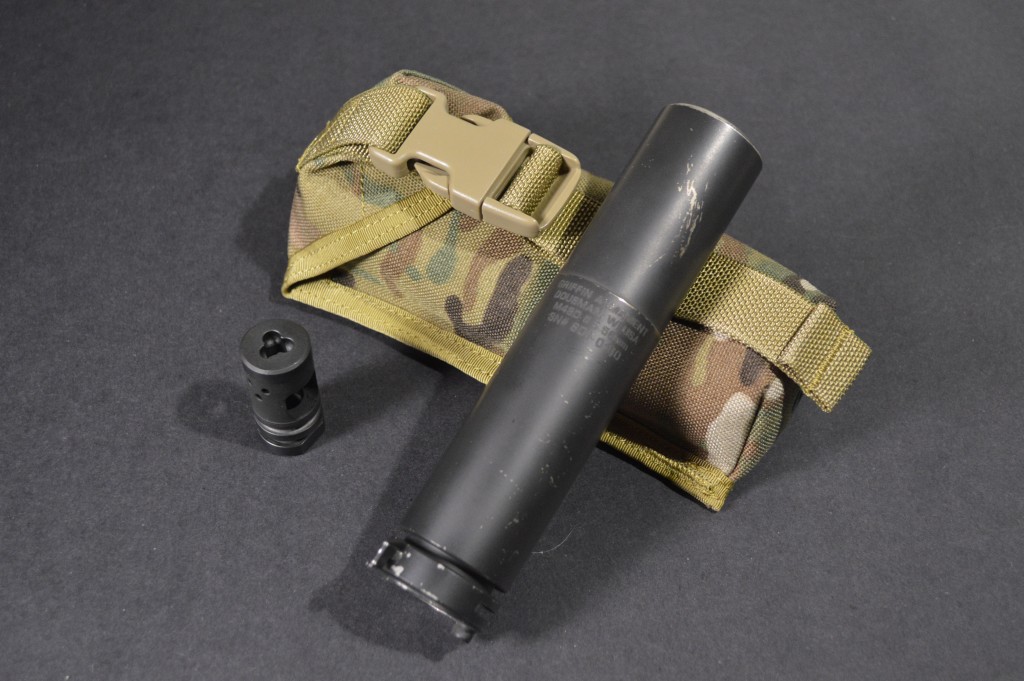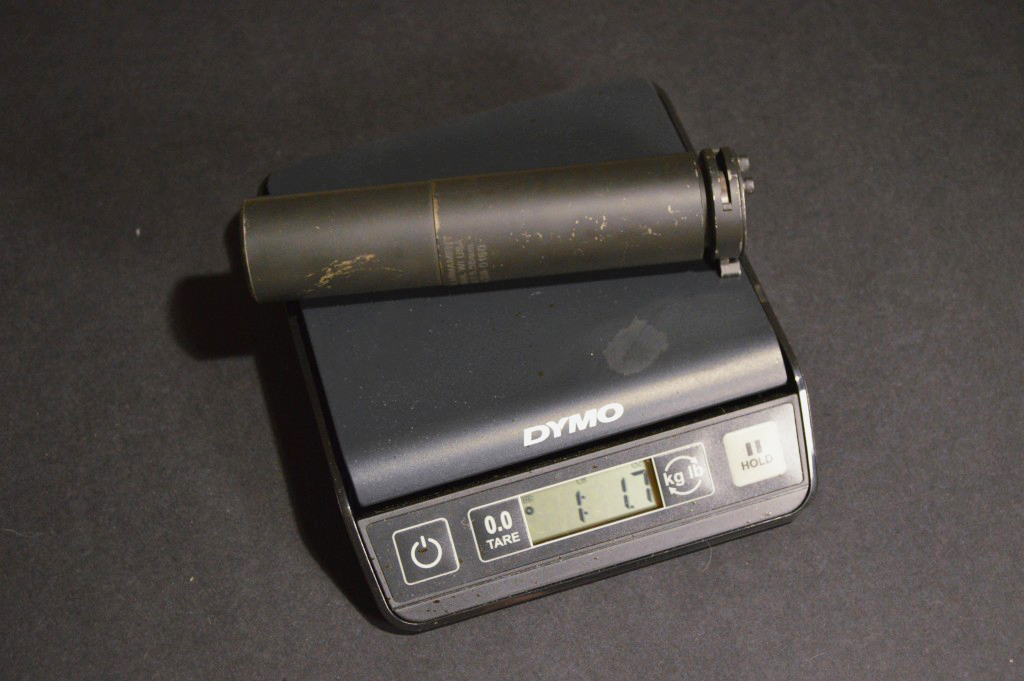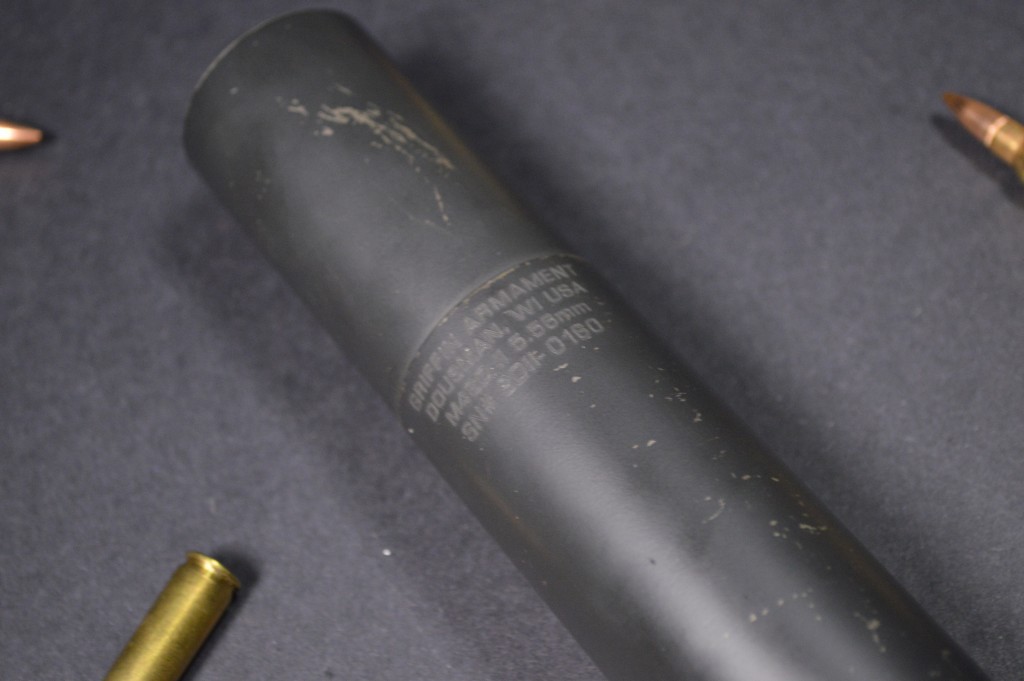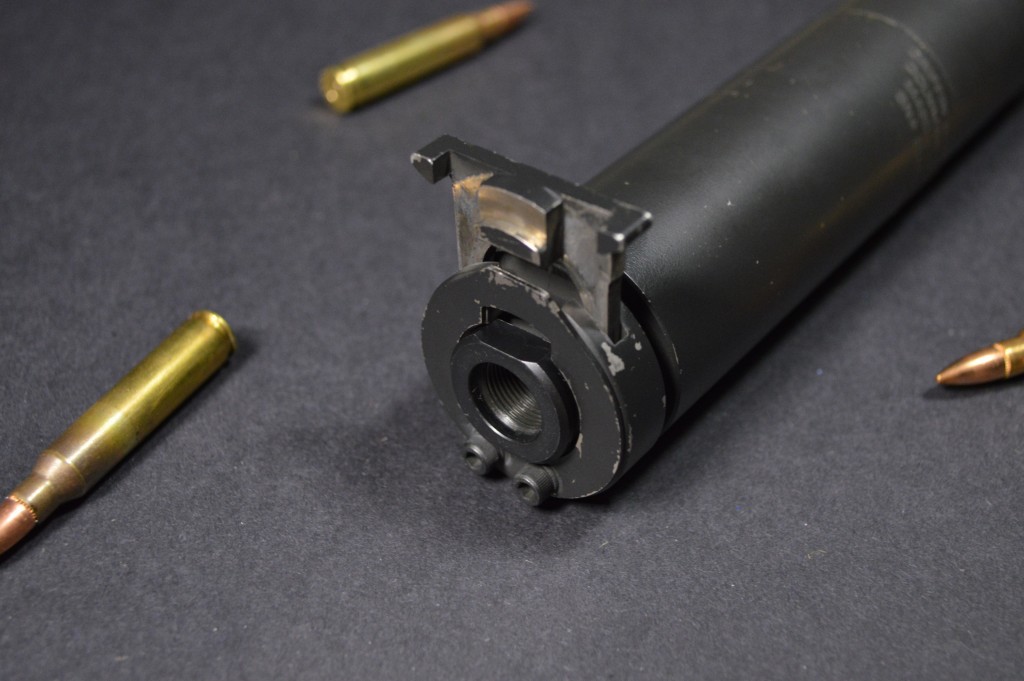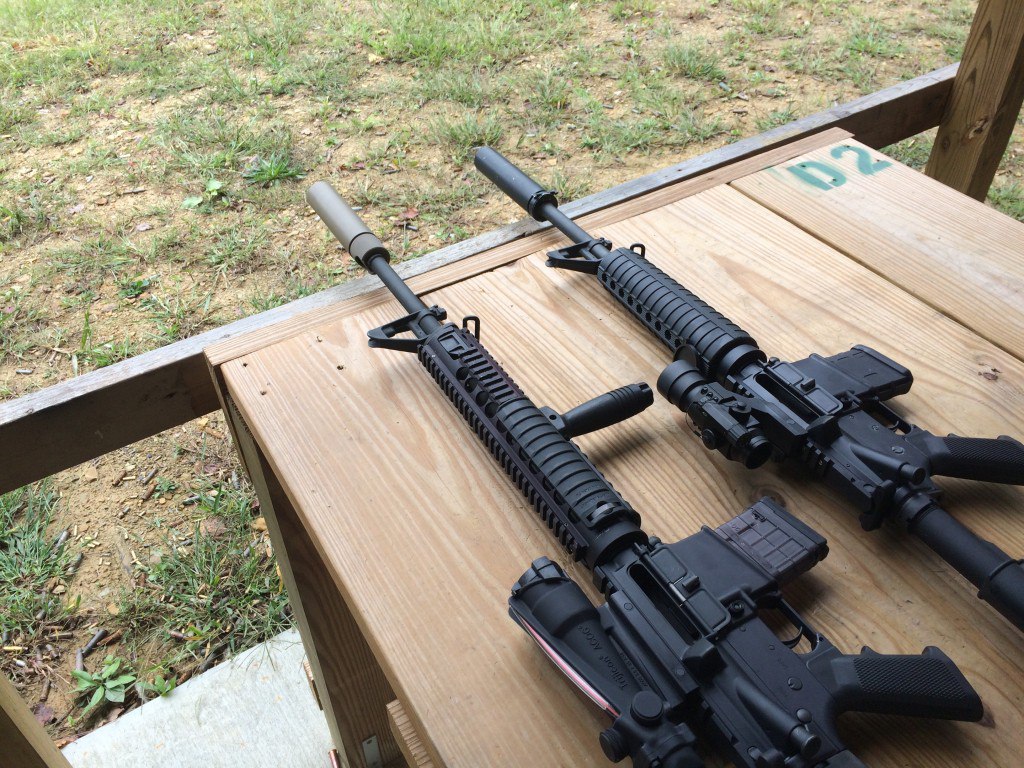Silencer Shop Authority: Griffin Armament M4SD II Review
Over the past few weeks, I’ve been testing similar suppressors next to one another in an attempt to better understand the wide variety of options on the market and to highlight differences between seemingly equivalent silencers. Last week, I examined Gemtech’s GMT-HALO as an option for my M16A4 clone and its A2 flash hider. Today, we will look at another A2-compatible silencer with Griffin Armament’s rugged M4SD II. While both suppressors are nominally similar, I think many readers will find them to be remarkably different takes on the concept.
Size and Weight
The Griffin M4SD II is a standard-sized 5.56mm suppressor at 6.625” in overall length and 1.5” in diameter. Mounted on a standard NATO A2 flash hider, the silencer adds just 4.875” to the rifle. As far as overall size and length added are concerned, the M4SD II is reasonably compact, but not quite on par with true “K” style silencers.
By itself, the M4SD II weighs in at 17.7 ounces according to my postal scale. This is right on par with other steel 5.56mm suppressors, but the bare weight of the can does not tell the whole story. Let’s compare it to my Specwar 556, for example. The Specwar weighs 19 ounces by itself, but the Trifecta ASR mounts add another 3 to 4 ounces, bringing the total system weight of that suppressor to as much as 23 ounces. The M4SD II, on the other hand, pairs nicely with a 2-ounce A2 flash hider or one of Griffin’s similarly light M4SD mounts for a total system weight of around 19.7 ounces. Whether or not this difference is noticeable will vary from rifle to rifle and shooter to shooter, but it should go to show that proprietary muzzle devices can add considerable weight to the front of a rifle and the M4SD II benefits from being able to use lighter NATO flash hiders.
Finish
My test Griffin M4SD II is coated in high-temperature Cerakote. Outside of some scrapes from hard demonstration use, the can’s finish has held up very well and seems unaffected by the high temperatures the suppressor has undoubtedly reached. Newer versions of the M4SD II feature Griffin’s proprietary Endura-Kote, which Griffin claims is more durable than Cerakote. As readers can see with this demo model, a more durable finish might have been a good move on Griffin’s part.
Mounts
One of the major advantages of the Griffin M4SD II is that it mounts to most A2 and similar NATO flash hiders. Unlike the Gemtech GMT-HALO I recently reviewed, Griffin’s system is an actual QD mechanism that allows one-handed attachment and removal with relative ease. At the rear of the suppressor is a locking gate that closes around the muzzle device at the blank firing adapter (BFA) groove. The locking gate is held in place by a spring that covers the rear face of the can and must be deflected outward to release the gate. In order to limit rotational movement, the locking gate has a flat cut into it that mates with either of the wrench flats on the flash hider. In my experience, this system locks down very securely, and after some practice, it can be very quick to deploy. Once mounted, the suppressor does have some rotational play, but it does not wobble, so baffle strikes should not be a concern.
One issue I did run into is that neither of the A2 flash hiders in my possession worked with the M4SD II. In both cases, the BFA grooves were too narrow for the locking gate to fit. Because of this, I had to swap the A2 on my M16A4 clone with an A1 unit that I found to work with the Griffin suppressor. According to Griffin Armament, approximately 5% of A2 flash hiders will not work with the M4SD II. The A2 flash hiders I have are from Bushmaster and DPMS. Since these manufacturers share the same parent company (Freedom Group), perhaps we should not read into my fitment issues too much. Regardless, shooters looking to pin their muzzle device to avoid short-barreled regulations will want to verify compatibility before attaching the accessory.
Unlike the GMT-HALO, the M4SD II does not have a face inside the blast chamber for muzzle devices to bottom out against. This is advantageous in one sense because it theoretically opens up more options for compatible flash hiders and muzzle brakes. Indeed if you look at Griffin’s M4SD line of accessories, you will see a myriad of devices, some of which are longer than others, and all of them are compatible with the M4SD II. On the other hand, a disadvantage of this system is that the suppressor tends to drop too far over the muzzle device during mounting. This is why Griffin includes a tabbed stop washer with their M4SD flash hiders and brakes, which prevents the can from dropping too far over the barrel.
Speaking of the M4SD muzzle accessories, Silencer Shop sent the suppressor over with the Paladin single port muzzle brake. Mounted on a friend’s Palmetto State Armory mid-length rifle, I was extremely impressed by the device. The brake has large ports at the 3 and 9 o’clock positions, as well as three smaller ports at 12 o’clock. While the Paladin was jarringly concussive to anyone standing adjacent to the rifle, it substantially tamed the already pleasant 5.56mm cartridge to near-.22 LR levels and seemed to add surprisingly little flash. Interestingly, despite being “precision ground” to work well with the M4SD II, I found that the suppressor still had noticeable rotational play when mounted on the Paladin.
At around $60, the Griffin muzzle accessories are relatively well priced and the options are indeed numerous. The M4SD II ships with one of their Hammer Compensators that offer recoil reduction similar to the Paladin, but also add some flash suppression. The beauty of the system is that users do not absolutely need one of these mounts in order to use the suppressor.
Materials and Design
The tested M4SD II features seven conical, clipped baffles that have been tightly packed inside the suppressor tube. The M4SD II series has undergone a number of revisions (four to be exact), so I cannot positively say that the new Mod 4 versions have the same baffle stack, but I believe it is similar. At approximately the halfway point of the blast chamber, Griffin has installed a ported washer to help support the front portion of the muzzle device when the can is mounted. Interestingly, the holes in this washer serve to enlarge the blast chamber and allow gasses to travel back towards the rear of the M4SD II. This is somewhat similar to a reflex suppressor, and it does seem to reduce blowback.
Throughout the M4SD II’s four revisions, Griffin has changed the suppressor’s build materials several times, and only recently has the company detailed these modifications. Initially, the silencer came with a 316L stainless steel tube and a fully Inconel baffle stack. Later, Griffin swapped the 316L tube for a tougher 17-4 stainless one. Based on feedback from Griffin co-owner, Evan Green, my demo came from this 17-4/Inconel series. In the most recent Mod 4 revision, Griffin has expanded the use of 17-4 stainless steel to include the suppressor’s entire baffle stack. The company claims that 17-4 is tougher than popular alternatives like Inconel and Stellite. Based on what I have seen, annealed 17-4 and Inconel do seem to be fairly close in terms of hardness and heat resistance, but I’m not sure I would choose them over satellite. Even so, this is mostly a pedantic discussion because few shooters are likely to put enough rounds through a suppressor at fast enough rate to warm it to a point where the differences come into play.
My test example has quite obviously been well used, but the suppressor seems unfazed by its round count. While the blast baffle is rough and no longer sports the smooth, shiny surface it once had, overall erosion is negligible. The bore and port seem to be well-shaped, and peering down the rest of the tube reveals a mostly pristine set of baffles. Griffin may have moved away from Inconel, but given the way that material shrugged off abuse, I expect 17-4 will work fine on all but the shortest of barrels (Griffin rates the M4SD II for barrels 10.5″ and longer). Shooters who are worried about the M4SD II’s longevity can always mount it on a muzzle brake for a sacrificial baffle.
With the Mod 4 revision, Griffin added cooling flutes or dimples to the outside of the M4SD II. These cuts give the tube a sort of golf ball appearance and add substantial surface area to the outside of the silencer. The Mod 4 is the first version of the suppressor to be visually different than previous releases.
Range Report
The M4SD II is by all measures, a high-performance suppressor. According to Silencer Shop and Military Arms Channel, Griffin’s flagship 5.56mm can be expected to offer 33 to 35 dB of sound reduction in most cases. This brings overall performance on your average 16” AR-15 to around 133 or 134 dB. Based on my experience with the M4SD II, I can attest to these numbers and will say it performs on par with my SilencerCo Specwar 556. For both shooters and bystanders, the M4SD II’s slightly lower tone and reduced ejection port noise beats the GMT-HALO, but the competition is close. If you watch the video embedded below and compare it to the GMT-HALO one I recorded, the amount of gas at the ejection port should be noticeably less with the Griffin can.
As far as 5.56mm suppressors go, the M4SD II exhibits remarkably little blowback. Sure, a certain amount of additional backpressure and gassiness are to be expected from suppressed ARs, but Griffin’s suppressor certainly seems to be on the lower end of the blowback scale. This is likely due to the large blast chamber and the perforated support ring that allows gas to travel back and around the muzzle device in a manner similar to reflex designs. The absolutely filthy brake that was revealed upon suppressor removal seems to indicate that the design worked as intended.
Point of impact shift with the M4SD II mounted falls right in line with the effects I have seen from similar 5.56mm suppressors. Mounted on the aforementioned A1 flash hider, I noticed a 1.5 MOA shift right and down. I was unable to adequately test the shift with Griffin’s Paladin brake, but Griffin claims their muzzle devices help to minimize POI changes. If we take the 1.5 MOA shift I saw as a worst case scenario, the M4SD II performs on par with many other 5.56mm suppressors.
Conclusion
Even before the M4SD II arrived, I expected I would like the design. The rugged build and solid performance are certainly noticeable with Griffin’s flagship 5.56mm silencer. That they are now on the fourth revision of this suppressor does seem to indicate that the company plans to continually improve on the design, which may irritate some early adopters, but on the whole is good for the industry.
Griffin’s locking gate system is very similar to the old KAC design and is quicker than Gemtech’s approach with the HALO. The suppressor’s compatibility with NATO muzzle devices saves shooters a considerable amount of money, especially when the plan is to share the silencer among several hosts, but I was discouraged to find that both of my available A2 flash hiders would not work with the M4SD II.
At around $830 from Silencer Shop, the Griffin Armament M4SD II is far from cheap. Still, it does offer additional value over competing silencers by way of its wide compatibility with common NATO muzzle devices. To some, the price may still be a turn-off when other QD suppressors with similar performance can be had at a lower cost. However, if you are a devoted clone builder or have multiple rifles to suppress, the Griffin M4SD II is worth considering over these competitors that require more expensive, proprietary mounting systems.
An information security professional by day and gun blogger by night, Nathan started his firearms journey at 16 years old as a collector of C&R rifles. These days, you’re likely to find him shooting something a bit more modern – and usually equipped with a suppressor – but his passion for firearms with military heritage has never waned. Over the last five years, Nathan has written about a variety of firearms topics, including Second Amendment politics and gun and gear reviews. When he isn’t shooting or writing, Nathan nerds out over computers, 3D printing, and Star Wars.

